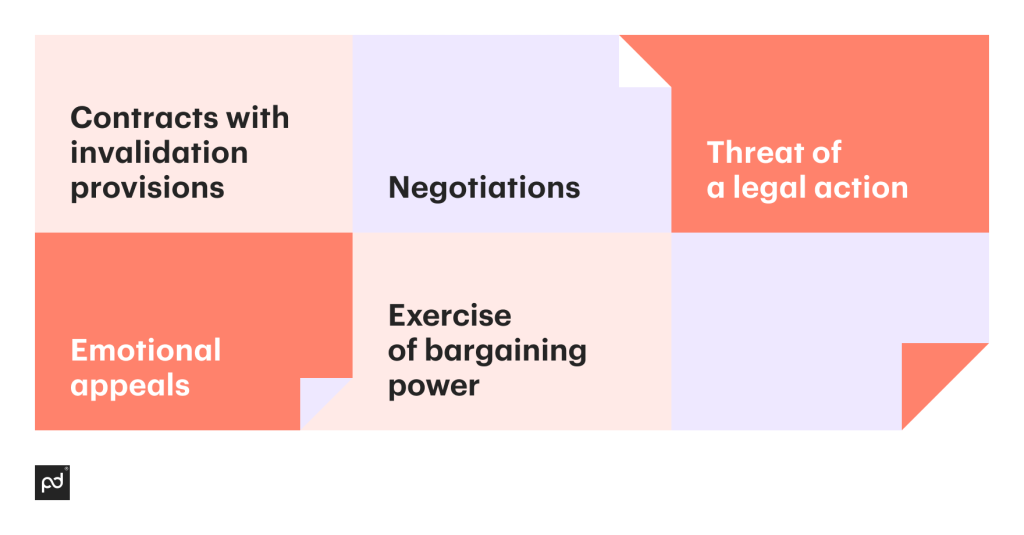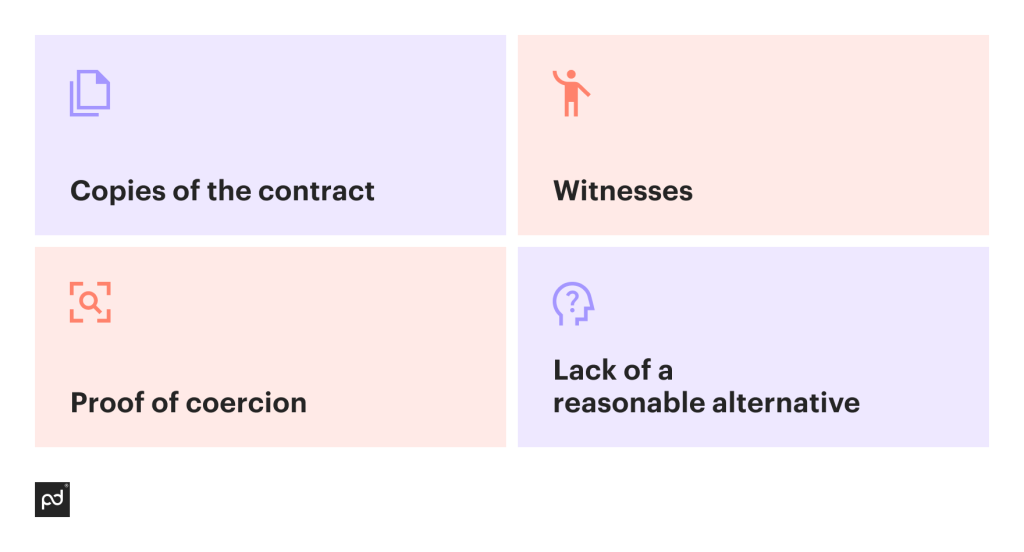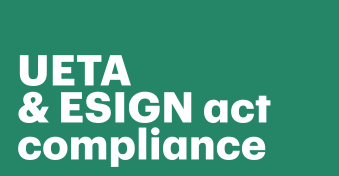Coercion is among the key reasons for a contract to be rendered invalid.
So if you or someone you know is forced into a contract, accepting it could possibly make the entire agreement void despite the signatures.
That said, making a court see it as such could be a challenge. In this article, we will describe what constitutes duress, illustrate it with a few examples, and give advice on how to prove it.
Key takeaways
- Signing under duress makes a contract unenforceable.
- Duress can include threats to a person’s wellbeing, freedom, and economic situation. It could also include a lack of a meaningful alternative.
- To get out of a contract signed under duress, get legal assistance and gather supporting evidence.
What is duress/undue influence?
Duress is the use of physical or psychological pressure to force a person into doing something.
This can include threats of violence to the person or their family members, bodily harm, imprisonment, or something affecting a person’s economic situation (so-called “economic duress”).
Another element of duress could be not having any reasonable alternatives to the offer.
If a person signed an agreement under duress, they didn’t do it of their own free will.
A contract like that becomes voidable.
Duress is a part of a wider issue known as undue influence, which also includes manipulation, misrepresentation, bad faith, etc.
What does it mean to agree under duress?
An important thing to note is that the threat must be of something wrongful in itself or putting a person/company in a situation where they have no choice but to sign.
Threatening to release embarrassing photos of someone, for example, could also constitute duress.
Not every type of pressure constitutes duress and not every agreement involving threats is unlawful. Examples include:

Contracts with invalidation provisions
Suppose one company has a contract to deliver hazardous materials to another company running processing plants in several states.
Once it’s revealed that a certain state declares it illegal to import anything hazardous, that part of the contract is severed — invalidated — and the remainder of the contract stays in place.
The shipping company may not like this outcome, but it’s entirely legal and not considered duress.
Negotiations
Even aggressive and persistent negotiations are legal — as long as they don’t involve any unlawful threats.
Threat of a legal action
Filing a lawsuit is a legal means to settle disputes. As such, it doesn’t usually constitute duress.
Emotional appeals
Using emotional tactics to influence someone’s decision do not typically qualify as duress unless they involve manipulation, exploitation, or abuse of a vulnerable individual.
Exercise of bargaining power
Engaging in negotiations and leveraging one’s bargaining power to secure favorable terms or outcomes does not necessarily constitute duress.
It is common for parties to use their leverage to achieve more advantageous results in a commercial contract.
Examples of signing under duress
As with many issues in contract law, whether something was done under duress is considered on a case-by-case basis.
To help illustrate making it more understandable we’ll show a couple examples.
B&S Contracts vs. Victor Greene Publications (UK)
Victor Greene Publications was going to hold an exhibition and hired B&S Contracts to erect the stands for it.
However, just a couple of days before the event was due to start, the building company got into a dispute with its workers, who demanded severance pay, as they were going to be laid off after the job was done.
Once the workers arrived at the place where the exhibition was going to happen, they stopped working until they got what they thought they were owed.
B&S asked VG representatives for additional money to complete the job. VG was initially willing to transfer £4,500 — half of the sum demanded by the workers — as an advance payment.
Due to a misunderstanding, B&S thought that it was an additional sum.
When they realized that it was considered an advance, they stated that it wouldn’t work and that they wouldn’t be able to do their job at all, unless VG pays that money in addition to the sum stated in the contract.
VG’s representative said “Well, you have me over a barrel” and paid.
Later, B&S received the sum stated in the contract minus that £4,500, so they sued.
The judge ruled that VG transferred the money under duress, because if the stands weren’t ready for an exhibition, it would leave the company financially ruined.
Brennan v. Bally Total Fitness (US)
Kathryn Brennan was an employee at Bally Total Fitness.
She complained to Fred Infante, her company’s lawyer and a contact person for employee complaints of harassment, that she was sexually harassed by her manager.
No actions were taken, so Brennan had to transfer to another facility of the company, which included a demotion, a pay cut, and a longer commute.
Later that year, she was asked to attend a meeting on the topic of sexual harassment, ran by the same Infante.
After she and about 20 other employees were shown a video about such incidents, they were given a 16-page single-spaced document with the procedure for bringing employee discrimination claims that mandated all complaints go to arbitration before going to court.
Infante took approximately 5 minutes to present it and didn’t mention the details like going into arbitration.
Employees who weren’t going to sign the document would not be considered for promotion.
Brennan signed it — she was afraid of being fired otherwise, as she had already brought a harassment claim earlier and thus could be considered a problem employee.
After Brennan eventually left the company, she sued for discrimination.
Despite Bally asking for arbitration, the court ruled the agreement was signed under duress.
Brennan didn’t have time to read and understand the document, Infante didn’t explain the consequences to her, and the growth at the company would be blocked for her otherwise.
How do you prove signing under duress?
If you claim duress, it is up to you to demonstrate that you were forced. To do so, you need to prove two things:
- There was a serious threat of a wrongful or an unlawful action
- There was no reasonable alternative to signing the contract.
To do that, you need evidence. It can include:

Copies of the contract
Using contract management software makes it easier, as it will allow you to monitor changes to the terms of the contract and review older versions of the documents (in case you were forced to change them).
Moreover, it will help share the documents with your lawyer.
You can start a free trial of such a system right now and see how it works with your own eyes.
Witnesses
In the above mentioned cases, all sides presented people who could corroborate their statements.
Witnesses could also be experts sharing their opinion on certain aspects of the situation — for example, your mental state, making you susceptible to threats.
Proof of coercion
This could be letters, emails, audio recordings, medical information, and other documents indicating that you were threatened or harmed.
Lack of a reasonable alternative
Like in the case of B&S Contracts vs. Victor Greene Publications, if you can show that you had no other choice but to sign, you have strengthened your case.
Getting out of a contract signed under duress
The first step should be to hire a local attorney that specializes in contract law.
Depending on your jurisdiction, there could be differences in procedures, rules, and precedents.
You will need legal advice anyway, so choosing one that knows how things are done in your area would be more beneficial.
The second step is to gather evidence to support your case.
Review the previous section and consult your lawyer to get an idea of where you should go.
If you haven’t signed a contract yet, make sure to record as much communication as you can — this will help you establish the lack of consent.
Finally, you need to file a lawsuit. Your legal counsel will do this on your behalf and guide you through all the steps of the process.
Conclusion
Proving duress is on the party that claims it.
So if you are forced into a contract, get qualified legal assistance as soon as you can.
Gather evidence like copies of contracts and proof of coercion, as well as witness testimonies.
Disclaimer
PandaDoc is not a law firm, or a substitute for an attorney or law firm. This page is not intended to and does not provide legal advice. Should you have legal questions on the validity of e-signatures or digital signatures and the enforceability thereof, please consult with an attorney or law firm. Use of PandaDocs services are governed by our Terms of Use and Privacy Policy.


